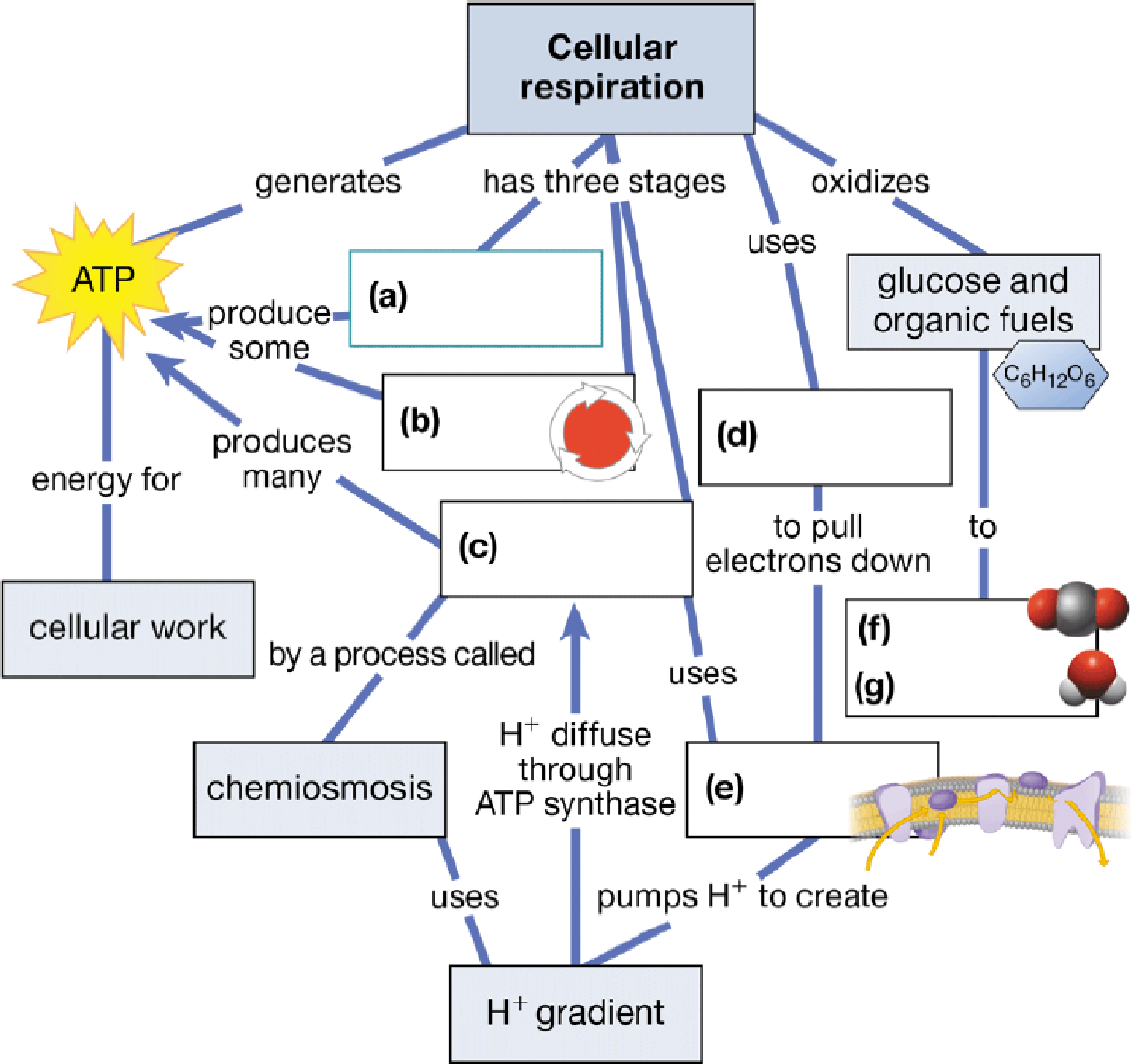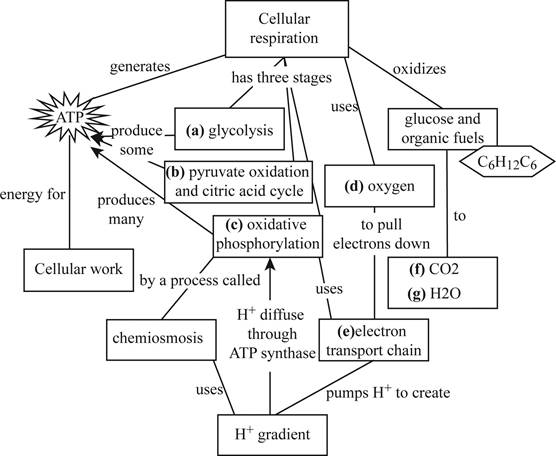
Concept explainers
Fill in the blanks in this summary map to help you review the key concepts of

To complete: The concept map to summarize the key concepts of cellular respiration.
Introduction:
The process of breathing and cellular respiration are closely associated. By breathing, an individual takes oxygen into the lungs and passes it to the blood. The blood carries the oxygen to cells where cellular respiration is carried out. Cellular respiration generates energy that is utilized for various cellular activities. There are several steps in cellular respiration; it includes glycolysis, pyruvate oxidation and citric acid cycle, and oxidative phosphorylation.
Answer to Problem 1CC
Pictorial representation: The Fig. 1 shows the vital concepts in cellular respiration.

Fig.1: Concepts map of cellular respiration.
Explanation of Solution
(a)
Correct answer: Glycolysis
Explanation:
Glycolysis is the first step of cellular respiration which occurs in the cytoplasm of the cell. The glycolysis process results in a breakdown of one glucose molecule into a three-carbon compound called pyruvate.
Hence, the correct answer is glycolysis.
(b)
Correct answer: Pyruvate oxidation and citric acid cycle
Explanation:
Pyruvate oxidation and the citric acid cycle are the second stage of the cellular respiration which takes place in the mitochondria. Here, pyruvate is oxidized into a two-carbon compound called acetyl Co-A. The citric acid cycle then completes the breakdown of glucose to carbon dioxide.
Hence, the correct answer is pyruvate oxidation and citric acid cycle.
(c)
Correct answer: Oxidative phosphorylation
Explanation:
Oxidative phosphorylation is the third stage of the cellular respiration. This involves electron transport and chemiosmosis. Oxidative phosphorylation is responsible for most of the ATP formation during the process of cellular respiration.
Hence, the correct answer is oxidative phosphorylation.
(d)
Correct answer: Oxygen
Explanation: Cellular respiration requires oxygen to trap the electrons in an electron transport chain. This helps in the generation of ATP by oxidative phosphorylation.
Hence, the correct answer is oxygen.
(e)
Correct answer: Electron transport chain
Explanation:
Electron transport chain is a series of an arranged molecular system in the mitochondrial cristae that passes the electrons to generate a proton potential across the inner mitochondrial membrane. This is required for oxidative phosphorylation and chemiosmosis.
Hence, the correct answer is electron transport chain.
(f)
Correct answer: CO2
Explanation:
Cellular respiration oxidizes the glucose and the organic fuels into carbon dioxide (CO2) and water molecules (H2O).
Hence, the correct answer is CO2.
(g)
Correct answer: H2O
Explanation:
Cellular respiration oxidizes the glucose and the organic fuels into carbon dioxide (CO2) and water molecules (H2O).
Hence, the correct answer is H2O.
Want to see more full solutions like this?
Chapter 6 Solutions
CAMPBEL BIOLOGY:CONCEPTS & CONNECTIONS
- Ch.23 How is Salmonella able to cross from the intestines into the blood? A. it is so small that it can squeeze between intestinal cells B. it secretes a toxin that induces its uptake into intestinal epithelial cells C. it secretes enzymes that create perforations in the intestine D. it can get into the blood only if the bacteria are deposited directly there, that is, through a puncture — Which virus is associated with liver cancer? A. hepatitis A B. hepatitis B C. hepatitis C D. both hepatitis B and C — explain your answer thoroughlyarrow_forwardCh.21 What causes patients infected with the yellow fever virus to turn yellow (jaundice)? A. low blood pressure and anemia B. excess leukocytes C. alteration of skin pigments D. liver damage in final stage of disease — What is the advantage for malarial parasites to grow and replicate in red blood cells? A. able to spread quickly B. able to avoid immune detection C. low oxygen environment for growth D. cooler area of the body for growth — Which microbe does not live part of its lifecycle outside humans? A. Toxoplasma gondii B. Cytomegalovirus C. Francisella tularensis D. Plasmodium falciparum — explain your answer thoroughlyarrow_forwardCh.22 Streptococcus pneumoniae has a capsule to protect it from killing by alveolar macrophages, which kill bacteria by… A. cytokines B. antibodies C. complement D. phagocytosis — What fact about the influenza virus allows the dramatic antigenic shift that generates novel strains? A. very large size B. enveloped C. segmented genome D. over 100 genes — explain your answer thoroughlyarrow_forward
- What is this?arrow_forwardMolecular Biology A-C components of the question are corresponding to attached image labeled 1. D component of the question is corresponding to attached image labeled 2. For a eukaryotic mRNA, the sequences is as follows where AUGrepresents the start codon, the yellow is the Kozak sequence and (XXX) just represents any codonfor an amino acid (no stop codons here). G-cap and polyA tail are not shown A. How long is the peptide produced?B. What is the function (a sentence) of the UAA highlighted in blue?C. If the sequence highlighted in blue were changed from UAA to UAG, how would that affecttranslation? D. (1) The sequence highlighted in yellow above is moved to a new position indicated below. Howwould that affect translation? (2) How long would be the protein produced from this new mRNA? Thank youarrow_forwardMolecular Biology Question Explain why the cell doesn’t need 61 tRNAs (one for each codon). Please help. Thank youarrow_forward
- Molecular Biology You discover a disease causing mutation (indicated by the arrow) that alters splicing of its mRNA. This mutation (a base substitution in the splicing sequence) eliminates a 3’ splice site resulting in the inclusion of the second intron (I2) in the final mRNA. We are going to pretend that this intron is short having only 15 nucleotides (most introns are much longer so this is just to make things simple) with the following sequence shown below in bold. The ( ) indicate the reading frames in the exons; the included intron 2 sequences are in bold. A. Would you expected this change to be harmful? ExplainB. If you were to do gene therapy to fix this problem, briefly explain what type of gene therapy youwould use to correct this. Please help. Thank youarrow_forwardMolecular Biology Question Please help. Thank you Explain what is meant by the term “defective virus.” Explain how a defective virus is able to replicate.arrow_forwardMolecular Biology Explain why changing the codon GGG to GGA should not be harmful. Please help . Thank youarrow_forward
- Stage Percent Time in Hours Interphase .60 14.4 Prophase .20 4.8 Metaphase .10 2.4 Anaphase .06 1.44 Telophase .03 .72 Cytukinesis .01 .24 Can you summarize the results in the chart and explain which phases are faster and why the slower ones are slow?arrow_forwardCan you circle a cell in the different stages of mitosis? 1.prophase 2.metaphase 3.anaphase 4.telophase 5.cytokinesisarrow_forwardWhich microbe does not live part of its lifecycle outside humans? A. Toxoplasma gondii B. Cytomegalovirus C. Francisella tularensis D. Plasmodium falciparum explain your answer thoroughly.arrow_forward

 Biology Today and Tomorrow without Physiology (Mi...BiologyISBN:9781305117396Author:Cecie Starr, Christine Evers, Lisa StarrPublisher:Cengage Learning
Biology Today and Tomorrow without Physiology (Mi...BiologyISBN:9781305117396Author:Cecie Starr, Christine Evers, Lisa StarrPublisher:Cengage Learning Human Physiology: From Cells to Systems (MindTap ...BiologyISBN:9781285866932Author:Lauralee SherwoodPublisher:Cengage Learning
Human Physiology: From Cells to Systems (MindTap ...BiologyISBN:9781285866932Author:Lauralee SherwoodPublisher:Cengage Learning Biology: The Dynamic Science (MindTap Course List)BiologyISBN:9781305389892Author:Peter J. Russell, Paul E. Hertz, Beverly McMillanPublisher:Cengage Learning
Biology: The Dynamic Science (MindTap Course List)BiologyISBN:9781305389892Author:Peter J. Russell, Paul E. Hertz, Beverly McMillanPublisher:Cengage Learning Human Biology (MindTap Course List)BiologyISBN:9781305112100Author:Cecie Starr, Beverly McMillanPublisher:Cengage Learning
Human Biology (MindTap Course List)BiologyISBN:9781305112100Author:Cecie Starr, Beverly McMillanPublisher:Cengage Learning Concepts of BiologyBiologyISBN:9781938168116Author:Samantha Fowler, Rebecca Roush, James WisePublisher:OpenStax College
Concepts of BiologyBiologyISBN:9781938168116Author:Samantha Fowler, Rebecca Roush, James WisePublisher:OpenStax College





